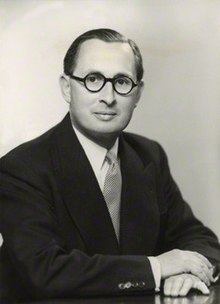Basil Smallpeice | |
|---|---|
 | |
| Born | 18 September 1906 |
| Died | 12 July 1992 (aged 85) |
| Education | University of London |
| Occupation | Company director |
| Board member of | British Overseas Airways Corporation (1953–1963) Cunard Line (1964–1971) Trafalgar House (1971–1972) Lonrho (1972–1973) |
| Spouses | Kathleen Singleton
(m. 1931; died 1973)Rita Burns (m. 1973) |
Sir Basil Smallpeice, KCVO (18 September 1906 – 12 July 1992) was an English accountant and businessman, who served as a director of several companies, including the state-owned airline British Overseas Airways Corporation (BOAC), the shipping company Cunard and the mining-based conglomerate Lonrho.
Smallpeice, as financial comptroller and later, managing director, was one of the board of BOAC who was instrumental in purchasing and introducing jet powered aircraft into passenger service. He was responsible for the purchase of the de Havilland Comet, the Boeing 707 and the Vickers VC10. His time at BOAC included the introduction of the Comet 1, the subsequent Comet disasters where metal fatigue caused the in-flight destruction of three aircraft, with a loss of 99 passengers and crew, the re-introduction of the Comet 4 and the inauguration of the first jet-powered transatlantic services in October 1958. He would later be instrumental in the purchase of the Boeing 707, which introduced the first by-pass turbofan engine, the Rolls-Royce Conway into passenger service. He left BOAC along with his chairman Matthew Slattery, over disagreements with the Government concerning financial support in return for purchasing the Vickers VC10.
He moved to Cunard as a director and then chairman, where he was responsible for radically altering the passenger and freight operations of the business; on the passenger side of the business, he cut massive losses by selling the Queen Mary and Queen Elizabeth liners, then oversaw the radical re-design of the replacement liner the Queen Elizabeth 2, which was under construction when he took up his position with Cunard. The changes he oversaw allowed the Queen Elizabeth 2 to become a profitable luxury liner for the company. His work on the freight size of the business included the containerisation of the business together with the amalgamation of smaller lines and the formation of joint ventures which would be needed to operate larger container ships. He was chairman of Cunard when the Atlantic Conveyor was ordered and launched as part of Cunard's contribution to the Atlantic Container Line joint-venture.
His final major business appointment was as a non-executive director of Lonhro, where soon after he took office, he uncovered illicit payments to Duncan Sandys and further impropriety undertaken by chief executive Tiny Rowland, who had committed company funds to projects without the agreement of the board and granted share options to other sympathetic board members. Smallpeice and seven fellow directors attempted to remove Rowlands from office on the grounds of his behaviour, but he managed to out-manoeuvre them by obtaining a temporary injunction preventing his removal. The Prime Minister Edward Heath considered Rowland's behaviour to be "the unacceptable face of capitalism" and despite support for Smallpeice and his fellow directors in the press and in the city, where they were dubbed "the straight eight", they all resigned at a subsequent extraordinary general meeting later in 1973.
Smallpeice also held a post as an administrative advisor to the household of Elizabeth II. He became well known and trusted by the Queen as a result of his work with BOAC organising flights and aircraft for the royal family, including the flight which took Princess Elizabeth to Kenya at the end of January 1952 and returned her as Queen several days later.